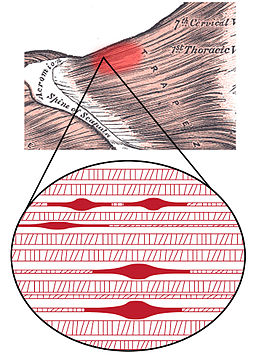What is a trigger point?
A trigger point is due to sensitized sensory nerves within a taut band of a muscle that when squeezed generates local and referred pain.
 The cause of a taut band is a hyperactive motor nerve branch, which generates sustained contraction in the muscle fibers attached to the motor endplate that the nerve branch supplies.
The cause of a taut band is a hyperactive motor nerve branch, which generates sustained contraction in the muscle fibers attached to the motor endplate that the nerve branch supplies.
A sustained ongoing contraction in a portion of the muscle (taut band) squeezes the blood vessels within the band and this diminishes perfusion and causes the build-up of metabolic by-products of the contraction in the muscle.
This metabolic waste aggravates and sensitizes the sensory nerve fibers (type IV or C-fibers) nearest the hyperactive motor end plate and these nerves will demonstrate mechanical allodynia (tenderness to light palpation pressure) and spontaneous pain.
Related Reading: How to Measure Orofacial Pain With a Muscle Tenderness Exam
Because these sensory nerve fibers fire spontaneously they start to cause central sensitization of the 2nd order neuron in the brain stem or spinal cord and when strongly stimulated causes referred pain.
Like what you’re learning? Explore our online Orofacial Pain & Oral Medicine degree.

What’s the difference between a latent and active trigger point?
An active trigger point is painful spontaneously and produces referred pain when squeezed. A latent trigger point is not painful spontaneously and produces referred pain only when squeezed.
What’s the difference between an active trigger point and an acupuncture point?
An active trigger point is located in a painful muscle. An acupuncture point(s) are specific locations on the body along known acupuncture meridians.
Why do you get referral pain palpating an active trigger point?
Referred pain occurs via a process called convergence referral.
Convergence means that several sensory nerves coming from different but adjacent myotomes and dermatomes in the patient converge on a single, 2nd-order pain transmission neuron. This neuron is usually a wide, dynamic range neuron and thus receives a variety of pain-specific nerve fiber input and low and high threshold mechanosensory (non-pain) input.
Related Reading: How to Conduct a Cranial Nerve Examination
Referral occurs because the constant firing of a pain sensory fiber from a trigger point changes the response characteristics of the 2nd-order pain transmission neuron making it more sensitive to lower threshold input. Because of this, input that is not painful is misinterpreted as pain and pain is then felt in areas that are not being directly stimulated (thus “referred” pain sensations).
Diagnostic Criteria of a Myofascial Trigger Point
- Patient has a regional pain complaint
- Identification of a palpable taut band
- There is an exquisitely tender trigger point along the length of a taut band on palpation
- Palpation of trigger point elicits referred pain
- There is some degree of restricted range of motion of the involved muscle
- Palpation of the trigger point usually should reproduce the clinical pain complaint
- A local twitch response may be elicited by transverse snapping of the trigger point
- Alleviation of pain by stretching the trigger point or anesthetic injection into the trigger point
Related Reading: How to Perform a TMJ Injection
Proper Trigger Point Palpation Technique
- Use your finger tips to move skin over muscle, not across the skin
- Palpate across the muscle fibers (perpendicular to the fiber direction), not along the fibers, to identify a taut band
- Apply about 2 kg (= 4.5 lbs) of pressure during palpation
- Use pincer technique to identify taut bands if the muscle can be picked up
- Compress points in the taut band for at least 3 seconds to ask about referral
Don’t forget to map trigger points and referral patterns. On a head and neck diagram indicate:
- The location of all trigger points
- The pain intensity of each trigger point
- The direction/pattern of all referred pain phenomena
Related Reading: Closed Lock Mobilization: TMJ Exercises & Stretches
Postgraduate Orofacial Pain and Oral Medicine Master’s Degree
Learn more about diagnosing, treating, and managing neuropathic pain disorders by enrolling in Herman Ostrow School of USC’s online, competency-based certificate or master’s program in Orofacial Pain and Oral Medicine.
